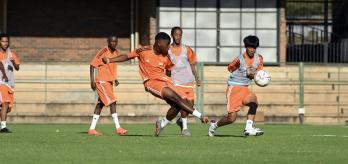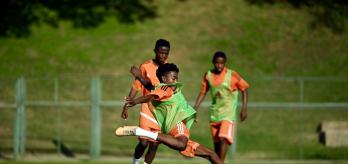Methodology
The intention: What is practised?
The objective of this game is to enhance a unit’s ability to create and finish when driving with the ball toward two defenders. The practice focuses on unit actions such as off-the-ball movements that create space for one another and combine to create chances. Ball-carriers must make split-second decisions on whether to pass to the forward and support or take the ball outside the defender should the possibility arise. If the pivot player is used, the third man must find a support run and the pivot player must recognise the space they will move into. A change of speed is required with dribbling, passing and movement to unbalance defenders and create gaps. When possible quick counter attacks must be prioritised using forward passes and aggressive movement off the ball.
The scale: For whom is this relevant?
This attack vs defence game focuses on a unit-level, with a particular focus on countering, breaking lines, movement to receive and finishing the attack. The game is particularly relevant to the attacking midfield and frontline in central areas. The 2 players carrying the ball can be considered as midfielders, attacking midfielders or wingers that have come inside during a transition whilst the forward pivot player can represent a centre-forward positioned beyond 2 opposing defenders. The centre-forward provides a link for one of the attackers to base a run off or act as a diversion creating space for a shot.
The practice type: How is the practice designed?
This practice involves an attack vs defence game featuring variable repetition that presents ample opportunities for a unit to practice combining with a pivot player when creating chances. The reduced pitch forces play centrally and the 2v2 scenarios ensure players must use short sharp movements to get past defenders. A focal point to the attack is presented with the use of the forward pivot player and the second neutral player offers support so that the unit can create momentum to shift defenders out of position. The 2 mini-goals provide direction to the game and two possible pathways that can be opened to create and finish in the final third. The additional variation of moving the mini-goals centrally limits those pathways and the target which requires quicker decision-making and more accurate execution.
Session plan
Organisation
-
Mark out a 25x15m exercise area. Place 2 mini-goals and mark out a 3-metre zone at either end of the exercise area.
-
Divide the group into 2 teams of 7 (blues and oranges), plus a group comprising 2 neutral players.
-
Set up a 2v2 scenario between the oranges and blues inside the exercise area and place the remaining players beside the mini-goals at either end of the exercise area.
-
Position a neutral player inside the 3-metre zone at either end of the exercise area.
Explanation
-
The exercise begins with the blues in possession. They try to score in either of the 2 mini-goals at the opposite end of the exercise area, while the oranges look to prevent them from doing so.
-
The blues can use the 2 neutral players, but if they play the ball backwards to the neutral player, they cannot use the same neutral player again in the sequence.
-
The neutral players can pass the ball to each other.
-
After each goal or attempt on goal, the 2 orange-team players are replaced by 2 of their team-mates, who come on to attack.
-
In this new sequence, the blues become the defending team.
-
The sequence is repeated after each goal or attempt on goal.
-
Rotate the neutral players at regular intervals.
-
Keep the score to help motivate the players.
Variation
-
Reduce the distance between the mini-goals.
Key coaching points
Roles of coaches
-
First coach: leads the exercise and brings the players together for a post-exercise discussion to ask them questions that require them to reflect on their actions.
-
Second coach: provides support from their position at one end of the exercise area.
-
Third coach: provides support from their position at the opposite end of the exercise area to the second coach.













































